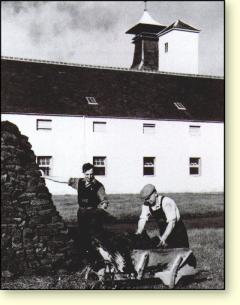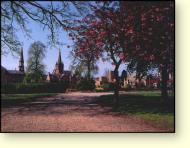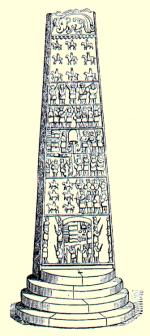
Location: Forres, Morayshire
Roads: Off the A940, one mile in direction of Rafford
Museum
Phone: 01309-672802
|
Text from The Whisky Trails, Copyright © Gordon Brown 1993:
The town of Forres may well be the ‘Varris’ that appeared on Roman maps of the district 2,000 years ago. Be that as it may, there certainly was a ninth-century Royal residence in the town and its layout today is mediaeval, with streets converging on the market place and narrow lanes linking them. Most of the old town buildings are 17th and 18th century and display the distinctive Scottish architectural feature of crow-stepped gables.

Forres is a quet Morayshire townm particulary colorful in spring.
|
Forres had two distilleries in full production at the beginning of the 1980s but, unfortunately, neither maintained the same status into the 1990s. Benromach closed in 1983 and Dallas Dhu went not long afterwards. Yet the latter lives on, fully rigged out and in production mode, as a living museum. It is open to visitors, its whisky is still available (although dwindling all the time), incomparably expert ex-distillery workers are often among those who show you round and you see the place exactly as it was when it was in production – all that is missing is that it does not actually distil whisky any more.
Dallas Dhu is such a perfect Highland distillery that, uniquely, it became the responsibility of the Scottish Historic Buildings and Monuments Department and is now officially a protected Ancient Monument. Appropriately, it is one of the distilleries designed by the talented Elgin architect, Charles Doig, much of whose work can still be seen around the Highlands today. It may even be he who invented the shapely rooftop pagoda head kiln-ventilators that distinguish distilleries so readily.
Dallas Dhu was completed in 1899. It was one of several distilleries located on the estate of a local laird, Alexander Edward, and the following year he handed Dallas Dhu over to the proprietors of Roderick Dhu, one of the popular whisky brands of the day. It was a prime site for distilling with water from the Altyre Burn and local barley, for long one of the best growing districts in Scotland. It was near the Highland Railway’s main line and the distillery had its own siding.
Due to the two World Wars, the depression and a fire that destroyed the stillhouse in 1939, production was an on/off affair until 1947 but the distillery played its part in the whisky boom of the following 30 years. One of the reasons Dallas Dhu kept its Victorian form was the limited water supply. Had there been more of it, much of what we see today, both inside and out, might well have been removed and replaced in pursuit of expanded production and efficiency.
It is a delight to walk round the floors and buildings being able to see in place and in sequence all of the machinery and equipment that is only partly present elsewhere. The barley-loft, the malting floor, the kiln, the malt mill and all the way through to the stillhouse and warehouses – they are all there.
Electricity did not reach Dallas Dhu until the 1950s and the waterwheel, driven by the overflow from the worm-tub, still contributed to the power pool into the 1970s. There is a single pair of stills, looking as if they could get under way at any moment.
The Whisky
Text from The Whisky Trails, Copyright © Gordon Brown 1993:
Dallas Dhu had some complexity and, although not quite a ‘big’ whisky, it had a silky, glyceral texture and botanical/floral bite. The final distillations were in 1983, so batches continue to crop up. Some 18-year-old and 1978 were recently available.
Source of water
Unknown
Of interest
Text from The Whisky Trails, Copyright © Gordon Brown 1993:

Sueno's Stone or Pillar, in the town of Forres, is thought to commemorate a battle with the Danes, but there does not seem to be any convincing explanation for the elephans at the top of the carving.
|
• Sueno’s Stone is a 23-foot carved Pictish upright stone dating from the ninth century. It commemorates a battle and the sculpting is extraordinary. Apart from some Ogam inscriptions and their broch towers, all that remains of the Picts, who shared Scotland with the Scots themselves from the third to the ninth centuries and simply disappeared, are these intricately carved stones which are scattered around the Highlands.